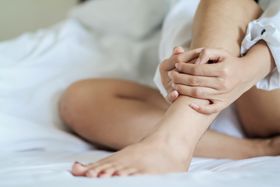Massages for Heel Spurs: Helpful Tips and Techniques
Updated May 2, 2023

A heel spur is a bony growth caused by calcium deposits on the heel bone. Typically, heel spurs are asymptomatic, meaning they do not cause any symptoms. They can, however, lead to significant heel pain, which is intermittent and stabbing. The American Association of Orthopaedic Surgeons (AAOS) affirms that 1 in 10 people has a heel spur, but only 1 in 20 individuals present with pain.
In addition to pain, heel spurs can cause redness, swelling, tenderness, and inflammation at the heel. While there is no known cause, several risk factors predispose you to heel spurs. Some of these causes of heel pain are tight calf muscles, obesity, improper shoes, and an abnormal gait pattern. Additionally, prolonged repetitive activities, high-impact activities (like running), and sudden changes in physical activity levels can cause heel spurs.
Benefits of Massaging Heel Spurs
While massage cannot cure heel spurs, it is beneficial in managing the symptoms of these growths. Massage relieves pain as it kneads away and soothes any tense muscles, ligaments, and surrounding tendons. It also reduces inflammation and improves blood flow to the area, which promotes healing.
It should be noted, however, that the benefits of massaging heel spurs are temporary, with surgery being the only permanent solution. Massage helps to decrease pain and inflammation, which are only the symptoms and not the spur itself.
Massage Techniques for Treating Heel Spurs
Several massage techniques can be used to treat heel spurs. Each method requires a different position and has varying degrees of complexity. They can be classified into three broad categories:
- Self-massage
- Massage by others
- Massage with equipment
1. Self-Massage
The first and most common technique is a simple self-massage. It involves massaging your foot with your hands while in a seated position. To perform this massage,
- Start at the base of the heel, where the plantar fascia connects to the heel bone.
- Gently applying pressure, knead the tension out of ligaments and muscles using a circular motion as you go.
- Then apply moderate to hard pressure on the plantar fascia running downwards from the ball of the foot.
- Continue for several minutes and repeat the process until every part of the heel has been covered.
2. Massage by Others
For each of the massage techniques below, you need someone to help you. This can be anyone you’re comfortable with or a trained professional like a physiotherapist. The advantage of getting a partner to work with you is that you can focus on relaxing your body while the person is busy with the massage. They can also work through the more painful areas you may have avoided. The techniques include:
Stroking Massage
While lying down, your partner should cup your heels in their hand. Then, they need to apply gentle pressure while stroking the top and sides of your feet with their fingers. The top strokes aim to relieve any kind of tension in the muscles and ligaments of the foot.
Deep Petrissage
For this technique, your partner uses the heel of their hands instead of the fingers to apply sustained pressure. They should apply this pressure steadily while moving from the ball of the foot to the heel.
Wringing Massage
Much like wringing a wet cloth, with a wringing massage, your partner holds your whole foot. Then, with hands facing opposite directions, they need to apply gentle pressure with each hand and twist their hands. Your partner should work from the ball of your foot to the instep and foot arch.
3. Massage With Equipment
These massages require implements like a tennis or golf ball, a foot massager, and in some cases, a water bottle.
Using a Golf Ball
To massage your feet with a golf ball or tennis ball:
- Sit in a chair with your feet facing forward.
- Place the heel of your foot over the golf or tennis ball.
- Roll your foot over the ball, beginning with the ball of the foot, moving to the sole. Apply as much pressure as you can.
- Repeat for a few minutes for each session.
Using a Foot Massager
In some instances, you can use a machine to massage the foot directly. To use foot massagers,
- Start slowly, placing both feet on the massager, so your feet get accustomed to it.
- Gradually increase the intensity of the vibrations while staying within a comfortable range.
- Use it for up to ten minutes at a time before stopping.
What Is the Fastest Way to Heal a Heel Spur?
While massage is effective for managing the symptoms caused by heel spurs, there are other ways to treat them. NSAIDs, ice, rest, splints, stretches for heel pain, orthotics, and local corticosteroid injections are all effective in bringing quick relief. The fastest way to heal a heel spur is to combine methods.
» Interested in other natural treatments? Discover the best heel spurs home remedies








